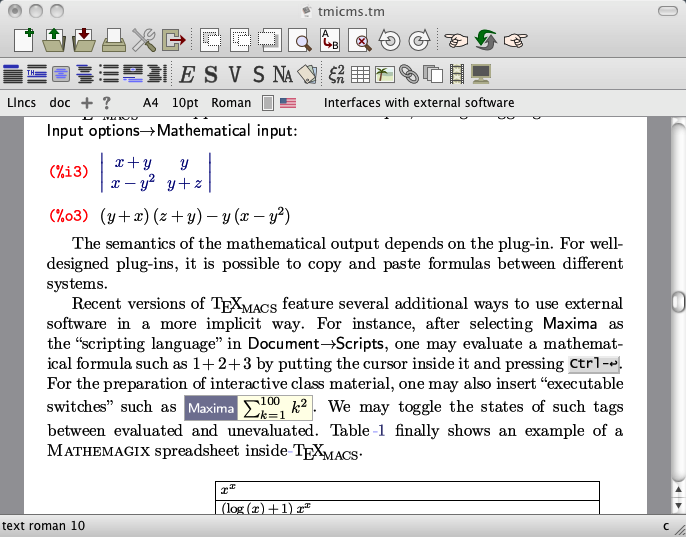 |
|
The GNU TeXmacs project aims to provide a free, polyvalent and
user-friendly scientific office suite, which can easily be interfaced
with a wide range of external mathematical software. The system can be
downloaded from www.texmacs.org. It should
be noticed that TeXmacs has been developed from scratch in
With respect to standard office suites such as Microsoft Word or Open Office, we offer better support for mathematical typesetting, formula editing, and other features useful for scientists. With respect to TeX/LaTeX [Knu84, Lam94] and its various front-ends, TeXmacs has the advantage of being completely wysiwyg (what you see is what you get). Indeed, the development of our system was initially motivated by the following reasons:
An editor should allow the author to concentrate on what is written and not on how it is written. In particular, editors should be as wysiwyg as possible.
With the advent of a wide variety of mathematical software, it should be possible to make documents more active. One might wish to incorporate computer algebra sessions and spreadsheets, for instance.
Scientific editors should become more integrated, taking example on office suits for non-scientific users. For instance, they should provide tools for drawing technical pictures, making presentations from a laptop, annotating texts, etc.
In this paper, we will present a quick survey of the traditional features of TeXmacs and continue with more recent improvements and new features. The next major release of TeXmacs 2.1 is planned for later this year.
The core of TeXmacs consists of a free wysiwyg scientific text editor, which includes a mathematical formula editor, the possibility to write structured texts, and to extend the editor using personal style files or customizations of the user interface. Advanced typesetting algorithms are used, which allow for the creation of high quality documents.
Gradually, more and more features have been added to the software, thereby moving towards our goal to provide a fully fledged scientific office suite. TeXmacs currently offers an editor for graphical pictures, a presentation mode, a rudimentary spreadsheet facility, integrated version control, etc. In addition, TeXmacs has been interfaced to many external mathematical computation systems. These interfaces can be used either in shell like sessions, inside spreadsheets, or on the fly inside regular text.
Our main objectives for the next major version TeXmacs 2.1 are to
increase the portability of the software and to further improve the user
experience. For these reasons, we completely redesigned the graphical
user interface (see Figure 1), which is now based on
The backbone of TeXmacs is a wysiwyg structured text editor. The user interface is redundant by design, so as to make the software suitable for users with diverse backgrounds. For instance, in order to create a new section, the user has the following options:
In the second icon bar, click on the  icon,
followed by a click on
icon,
followed by a click on
As in LaTeX, type \SECTION followed by ↩.
Use the keyboard shortcut Alter-1.
In a similar way as in LaTeX, authors are invited to concentrate on intent rather than presentation. Nevertheless, most tags have a sufficiently distinctive presentation for making the structure apparent from the mere rendering of the document.
All documents are internally represented and manipulated as trees. The structure of the documentation is made more visible to the user by putting non intrusive boxes around all tags which contain the cursor. The innermost tag is called the current focus and is highlighted using a special color. Various editing operations allow the user to directly operate on the structure of the document. For instance, if the current focus is a section title, then there are actions for changing it into a subsection title, to jump to the next and the previous section, to toggle the numbering, or to get contextual help on the section tag.
An analogue of the “LaTeX source code” is available in
TeXmacs using 



 to be just as good (and arguably even better) a
“source code” as \sqrt{x}.
to be just as good (and arguably even better) a
“source code” as \sqrt{x}.
TeXmacs also allows the user to create new style sheets or to modify the definitions of existing presentation macros. In recent versions, this kind of customizations have been made even easier: we both provide simplified widgets for editing macros and the possibility to jump directly to the definition of the macro corresponding to the current focus.
Special care has been taken so as to make the input of mathematical formulas particularly efficient. First of all, we designed a special input method which allows users to enter most mathematical symbols are obtained using a small set of basic rules:
Characters which are naturally obtained as
“superpositions” or “concatenations” of
symbols on your keyboard are entered in a straightforward way. For
instance, ->
yields  , <=
yields
, <=
yields  , +- yields
, +- yields  and << yields
and << yields  .
.
The “variant” key ⇥ may be used in order to
obtain variants of a given symbol or keyboard shortcut. For
instance, <=⇥
yields  , <=⇥⇥⇥
yields
, <=⇥⇥⇥
yields  , <⇥
yields
, <⇥
yields  and <|⇥ yields
and <|⇥ yields
 . All Greek letters can
be obtained as variants of the Roman ones: A⇥ yields
. All Greek letters can
be obtained as variants of the Roman ones: A⇥ yields
 , L⇥ yields
, L⇥ yields
 and so on. Sometimes, additional variants
are available: B⇥⇥
yields
and so on. Sometimes, additional variants
are available: B⇥⇥
yields  and E⇥⇥
yields the mathematical constant
and E⇥⇥
yields the mathematical constant  .
.
The /
and @
keys are used for obtaining negations and symbols inside other
symbols. For instance, <=/ yields  and @+ yields
and @+ yields  . More elaborated examples are @⇥+
and <⇥=⇥/⇥,
which yield
. More elaborated examples are @⇥+
and <⇥=⇥/⇥,
which yield  resp.
resp.  .
.
Efficient shortcuts are also available for most mathematical constructs: ⌥F starts a fraction, Alter-S a square root, _ a subscript, ^ a superscript, etc. Being faithful to the principle of redundancy, these actions can also be performed through the menus, the icons, or via LaTeX equivalents.
Inside a mathematical formula, the cursor keys allow you to move around in a graphically intuitive way. In particular, when done with a particular subformula, it usually suffices to press the right arrow key → in order to return to the main formula.
Wysiwyg editors are especially interesting for more complex formulas. For instance, it is easy to insert new rows and columns inside a matrix, or to copy and paste submatrices (and not only rows).
Another particular feature of TeXmacs is that formulas carry more
semantics than in LaTeX, when entered appropriately. For instance,
“invisible” multiplication (as in  ) should be entered explicitly using *, whereas function
application (as in
) should be entered explicitly using *, whereas function
application (as in  ) should
be entered using ␣.
) should
be entered using ␣.
Recent versions of TeXmacs integrate a parser for mathematical formulas
and a syntax checker. When activating “semantic editing”
from the  icon menu, the focus box indicates the
arguments of mathematical operators and its color changes to red
whenever a formula is syntactically incorrect. The mathematical formula
parser is based on a fixed grammar which works on a wide variety of
mathematical texts. Nevertheless, the user can explicitly modify binding
forces when needed and define specific notations using the standard
macro mechanism. We refer to [Hoe11] for more details.
icon menu, the focus box indicates the
arguments of mathematical operators and its color changes to red
whenever a formula is syntactically incorrect. The mathematical formula
parser is based on a fixed grammar which works on a wide variety of
mathematical texts. Nevertheless, the user can explicitly modify binding
forces when needed and define specific notations using the standard
macro mechanism. We refer to [Hoe11] for more details.
TeXmacs has been interfaced with many external systems [Gro01].
In particular, we have interfaces for the computer algebra systems
The traditional way to use “plug-ins” is through “shell sessions”:
(%i1) |
diff (x^x^x^x, x); |

(%i2) |
integrate (%o1, x); |

TeXmacs also supports two-dimensional input, through toggling of 

(%i3) |

The semantics of the mathematical output depends on the plug-in. For well-designed plug-ins, it is possible to copy and paste formulas between different systems.
Recent versions of TeXmacs feature several additional ways to use
external software in a more implicit way. For instance, after selecting
Maxima as the “scripting language” in 
 by putting the cursor inside it and pressing Ctrl-↩. For
the preparation of interactive class material, one may also insert
“executable switches” such as
by putting the cursor inside it and pressing Ctrl-↩. For
the preparation of interactive class material, one may also insert
“executable switches” such as
. We may toggle the states of such tags between evaluated
and unevaluated. Table 1 finally shows an example of a

We have seen that TeXmacs integrates a structured text editor, a formula editor, a spreadsheet facility and many interfaces to external programs. Let us describe a few other tools that are available nowadays inside our system, which make TeXmacs a fairly complete scientific office suite.
A wysiwyg editor such as TeXmacs is particularly useful for preparing
laptop presentations. For this, it suffices to select 
Special markup is provided for showing and hiding content in specified orders. For instance, the “unroll” tag allows item lists to be unrolled progressively. There is also support for general “overlays”, where the user has full control over the order in which content appears and disappears on specified ranges of overlays.
The 
Existing pictures can be embedded inside a document using 







TeXmacs comes with an efficient tool for computing and visualizing
“structured differences” between two versions of a document.
The default way to visualize changes is to show the old and new versions
side by side in different colors. Authors may quickly go trough the
changes introduced by a coauthor and select which versions they prefer.
TeXmacs also integrates support for external versioning software. For
the moment, we only provide an interface for
Unfortunately, TeXmacs is not yet as wide-spread as LaTeX. For the sake of backward compatibility, TeXmacs provides high quality converters from and to LaTeX. However, these converters cannot be perfect for several reasons.
The main reason is that LaTeX is not a format, like
The other main reason is that TeXmacs has a more powerful typesetting engine than LaTeX and that it provides several extensions (like a graphical editor or animations) which are not available in LaTeX. Therefore, a conversion to LaTeX may downgrade your document, both in typesetting quality and in structure. For instance, TeXmacs pictures are exported as postscript images, so their structure is lost.
Nevertheless, during recent years, we have invested a lot of energy in making the LaTeX converters as good as possible, in both directions. In particular, we support the most frequently used LaTeX styles. The behaviour of the converters can be fine-tuned for specific needs via the user preferences. For instance, should macros be expanded or not during conversions? Are preambles allowed to contain additional macro definitions? Etc.
An interesting recent addition is the possibility to use the converters in a “conservative” fashion [HP14]. For instance, assume that Alice writes a document in LaTeX and sends it to Bob. Bob opens the document in TeXmacs, makes a few modifications and exports the document back to LaTeX. Conservative converters have the property that the exported document will be almost the same as the Alice's original version: ideally speaking, only Bob's changes will really be exported.
Besides LaTeX, reasonably good converters for
Last but not least, TeXmacs is wysiwyg, which means that TeXmacs
traditionally features a lossless converter to
TeXmacs can be customized in many ways. Besides the possibility to write your own style files for the presentation of documents, it is also possible to customize the behaviour of the editor, or to write new plug-ins for external software. We will briefly give a few examples below. Questions can be asked on our mailing lists:
http://www.texmacs.org/tmweb/home/ml.en.html
The user may define new typesetting constructs or customize the
rendering of the standard styles using a special macro language. For
instance, one may define a macro
|
This macro may then be used by typing \CD↩, as in

For more information, we refer to 


Following the example of GNU
(kbd-map
(:mode in-text?)
("T h ." (make 'theorem))
("D e f ." (make 'definition))) |
Then the keyboard shortcuts ⇧TH. and ⇧DEF.
can be used inside text mode in order to insert a theorem
resp. a definition. In a similar way, you may customize the
menus, or add more complex extensions to the editor. For more details,
we refer to 
A. G. Grozin. TeXmacs interfaces to Maxima, MuPAD and Reduce. In V. P. Gerdt, editor, Proc. Int. Workshop Computer algebra and its application to physics, number 11-2001-279 in JINR E5, page 149, Dubna, June 2001. Arxiv cs.SC/0107036.
J. van der Hoeven. Towards semantic mathematical editing. Technical report, HAL, 2011. http://hal.archives-ouvertes.fr/hal-00569351, submitted to JSC.
J. van der Hoeven and F. Poulain. Conservative conversion between LaTeX and TeXmacs. Technical report, HAL, 2014. http://hal.archives-ouvertes.fr/hal-00952926.
L. Lamport. LaTeX, a document preparation system. Addison Wesley, 1994.